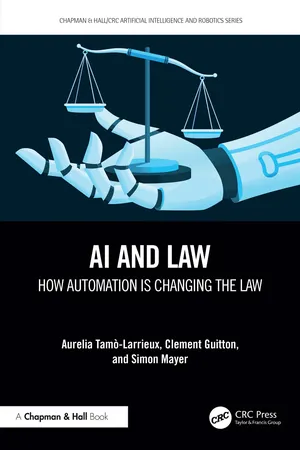
AI and Law
How Automation is Changing the Law
- 272 pages
- English
- ePUB (mobile friendly)
- Available on iOS & Android
About this book
This book provides insights into how AI is changing legal practice, government processes, and individuals' access to those processes, encouraging each of us to consider how technological advances are changing the legal system. Particularly, and distinct from current debates on how to regulate AI, this books focuses on how the progressive merger between computational methods and legal rules changes the very structure and application of the law itself.
We investigate how automation is changing the legal analysis, legal rulemaking, legal rule extraction, and application of legal rules and how this impacts individuals, policymakers, civil servants, and society at large. We show through many examples that a debate on how automation is changing the law is needed, which must revolve around the democratic legitimacy of the automation of legal processes, and be informed by the technical feasibility and tradeoffs of specific endeavors.
Frequently asked questions
- Essential is ideal for learners and professionals who enjoy exploring a wide range of subjects. Access the Essential Library with 800,000+ trusted titles and best-sellers across business, personal growth, and the humanities. Includes unlimited reading time and Standard Read Aloud voice.
- Complete: Perfect for advanced learners and researchers needing full, unrestricted access. Unlock 1.4M+ books across hundreds of subjects, including academic and specialized titles. The Complete Plan also includes advanced features like Premium Read Aloud and Research Assistant.
Please note we cannot support devices running on iOS 13 and Android 7 or earlier. Learn more about using the app.
Information
Table of contents
- Cover
- Half Title
- Series Page
- Title Page
- Copyright Page
- Dedication
- Table of Contents
- Preface
- Authors
- Chapter 1 ◾ Automation of Law
- Chapter 2 ◾ Law and Computer Science Interactions
- Chapter 3 ◾ Automatically Processable Regulation
- Chapter 4 ◾ Challenges and Controversies
- Chapter 5 ◾ Needed (Public) Debates
- Chapter 6 ◾ How Education Should Shift
- Chapter 7 ◾ Exercises
- Epilogue
- Acknowledgments
- Guiding Approaches for Solutions
- References
- Index